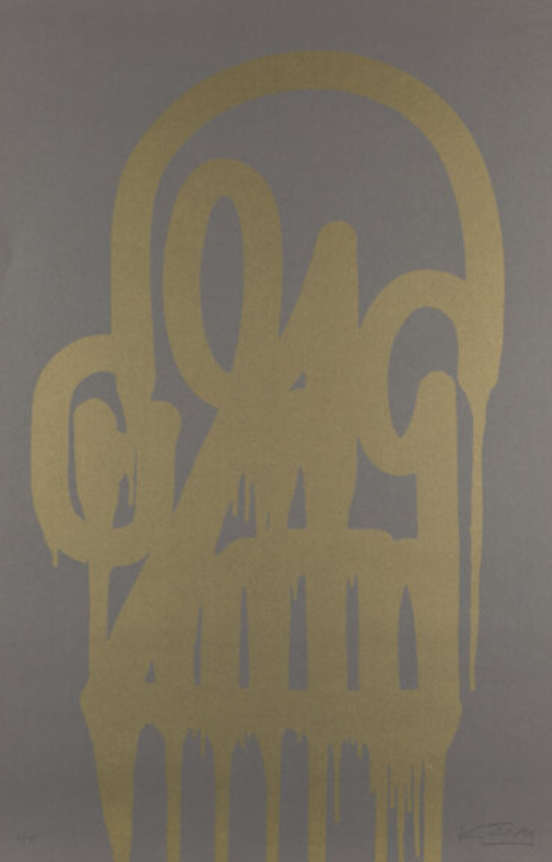
Street Art
-

Katsu Timeless Skull Metallic Gold Shadow Metallic Silkscreen Print by Katsu
Timeless Skull Metallic- Gold Shadow Limited Edition Gold Metallic Ink on Shadow Metallic Paper by Katsu Graffiti Street Artist Modern Pop Art. 2015 Signed & Numbered Limited Edition of 75 Katsu Artwork Size 25x39. I was scuffing On the Lower and middle Of the Paper. "Skulls are the universal image for rebellion; Pirate flags use them as the ultimate offense, cannibals decorate their camps with them, and the skull represents how I live my life. The single-stroke skull came out of my desire to tag faster. As a young tagger, I became fascinated with the practicality of tagging different designs and shapes. I wanted to engineer an attractive design from an artistic standpoint and from the idea of efficiency. The skull is how I condemn surfaces, structures, how I condemn the public space." - KATSU Katsu's Affinity for the Skull Motif Skulls have long been a symbol of rebellion and nonconformity in various subcultures, and in the realm of street art, they hold a particularly potent significance. The skull is not just a morbid fascination but a statement, a form of resistance, and for the street artist Katsu, it is a canvas of condemnation and a mark of efficiency. This piece delves into the significance of Katsu's limited edition gold metallic ink on shadow metallic paper artwork and its place in contemporary street art. Katsu's little edition work, a striking fusion of gold metallic ink on shadow metallic paper, presents a skull in a visually arresting and thematically rich way. With only 75 pieces created, the exclusivity of the artwork amplifies its impact on modern pop art. Katsu's approach to the skull is deeply rooted in his identity as a street artist. He recognizes the skull as a universal emblem of defiance, reminiscent of pirate flags and tribal decorations. His interpretation, however, is unique in its simplicity and speed. The single-stroke skull that characterizes Katsu's work emerged from a youthful fascination with the efficiency of tagging. This desire to create swiftly without sacrificing aesthetic appeal has led to a minimalist yet powerful representation of the skull. The Impact of Katsu's Work on Public Spaces Katsu sees his skulls as more than just art; they are a statement against the structures and surfaces they adorn. By placing his work in public spaces, Katsu engages in a dialogue with the viewer, often without their consent. This act of 'condemning' public spaces is a form of social commentary and a challenge to the norms that govern our visual landscape. In doing so, Katsu aligns with the core tenets of street art: accessibility, anonymity, and transience. His skulls are not meant to be preserved in galleries but experienced in the wild, where they can confront and provoke thought. The technical aspects of Katsu's work are as fascinating as the ideological. Using gold metallic ink on shadow metallic paper is a deliberate choice that plays with light and perspective. The reflective quality of the gold ink catches the viewer's eye, while the shadowy backdrop adds depth, making the skull appear to emerge from the darkness. The contrast symbolizes the interplay between life and death, presence and absence. Katsu's limited edition pieces are a testament to his mastery of materials and ability to imbue a static image with a sense of life and motion. Katsu's Legacy and Influence on Modern Pop Art Katsu's skulls are more than a personal signature; they are a part of the larger narrative of street art's evolution. By adopting a symbol with history and giving it a modern twist, Katsu positions himself within a lineage of artists who use the urban landscape as their canvas. His work bridges graffiti's raw, gritty beginnings and the polished, thought-provoking installations of contemporary street art. As such, Katsu's skulls are not just art pieces; they are cultural artifacts that capture the zeitgeist of a movement that continues to challenge and redefine the boundaries of public art. In the ever-evolving world of street art, Katsu's metallic skulls stand as a testament to the power of simplicity and the enduring allure of rebellion. Through a single stroke, Katsu conveys a narrative of defiance and a challenge to the viewer, making his limited edition series a coveted piece for collectors and enthusiasts of modern pop art. His work remains a crucial point of reference for understanding the dynamics of street art and its unyielding quest to transform the mundane into the extraordinary.
$995.00


